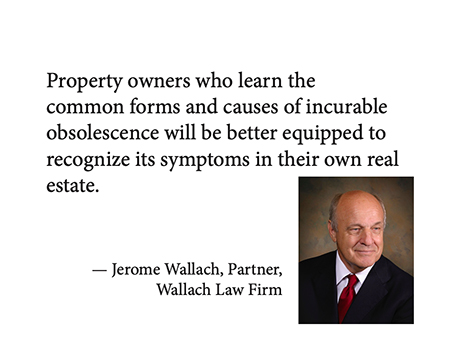Incurable obsolescence — the stealth killer of commercial real estate value — is all too often overlooked in property tax appeals.
Any obsolescence can affect a property’s value. Normal obsolescence involves curable problems, such as outdated fixtures and finishes that reduce a building’s desirability. In valuation, the anticipated cost to cure the obsolescence (in this case, with a refreshed interior) is deducted from the property’s taxable value.
As the name suggests, incurable obsolescence cannot be cured within the boundaries of the property. The obsolescence stems from outside circumstances, whether next door or in the larger markets, and no change to the property itself can overcome the deficiency.
Perhaps the government is going to change the traffic pattern, or a hog farm is going in next door. The market value may rise if a good thing is coming to the area. It will surely decline if a bad thing is coming, and the market value declines in relation to the predictability of such an event.
Property owners who learn the common forms and causes of incurable obsolescence will be better equipped to recognize its symptoms in their own real estate. In arguing for a reduced tax assessment value, evidence of obsolescence weighing on a property’s operations will often tip the scales in convincing an assessor, review board or court to grant a reduction.
Passing or permanent?
Owners should be aware of functional obsolescence and be prepared to discuss it when appealing assessments. If it is a problem that can’t be cured within the boundaries of the property, it is incurable obsolescence and reduces the property’s market value.
The condition may have existed from the inception of the property’s development and use, but more typically it results over time from factors relating to design, usability, markets, traffic patterns, government takings or regulation. For example, economic need or a government requirement may leave a property without adequate parking to support commercial buildings on the site, rendering those structures incurably obsolete.
Incurable obsolescence can be partial and a handicap to the property’s viability without entirely preventing its continued use. For example, an office building designed for single-tenant use will not accommodate multiple users. There is a very limited market for single-tenant, high-rise buildings. The cost of retrofitting such a building into separate leasable offices is infeasible.
The loss in value due to incurable obsolescence may be anticipatory. If the market’s users and investors see imminent incurable obsolescence, it may already affect market value. The negative impact of incurable obsolescence occurs when the problem cannot be cured on site at any cost.
In evaluating a property for instances of incurable obsolescence, however, it is important to remember that the source of obsolescence may be offsite.
Owners concerned with the production and marketing of a product or service from their property may not be aware of external elements of incurable obsolescence affecting their property’s value. Or they may simply regard the circumstance as a non-priority item — at least until they get their property tax bill.
Instances of the incurable
Incurable obsolescence takes many forms, but taxpayers are most likely to encounter it in one of a few common scenarios. Those include:
Property access changes. Typically imposed by a highway or street authority, moving or removing access points can reduce a commercial property’s appeal to users and lower its market value.
Altered traffic patterns. Changes to surrounding roads or highways can reduce commercial value. Limiting the property’s visibility and accessibility, for example, may reduce customer traffic and brand exposure for operators on the property.
Size modifications. The property may fail to meet the required property size in relation to improvements. Possible causes include changed government requirements or the physical loss of a portion of the property due to government taking. A simple change in setback lines may have a dramatic negative impact on a property’s value.
Takings. Use of eminent domain may reduce the remainder of the property to a legal non-conforming use which may not be altered to accommodate a commercially viable use. Alternatively, commercial uses on a state highway may be untouched by highway takings, but diverting traffic to a new highway kills viable commercial use of properties on the abandoned roadway.
More examples
Other sources of incurable obsolescence span a wide range, from changing industry practices and preferences to evolving government regulations, markets and natural phenomena. Zoning or regulatory changes may restrict usage, for example. The property may no longer meet current tenant needs regarding loading dock height, or access by delivery and customer vehicles. Nearby development or street construction may inundate the property with surface water. Properties have incurred incurable obsolescence for their intended uses from light pollution, and from disruptive air traffic following a change in flight patterns.
Property owners discussing excessive taxable valuation with the assessor should recognize that the assessor has employed the cost approach to value. While cost may be a value indicator, it lacks relevance in situations involving incurable obsolescence. Help the assessor to look beyond cost by showing how obsolescence reduces the property’s value in the marketplace.
In preparation for meeting with the assessor, an owner seeking a reduced assessment should look for negative conditions beyond the control or ability of the owner to correct within the boundary of the property. Be prepared to discuss with the assessor how the conditions affect the property value. Bring plat maps, photos, restrictive regulations and ordinances, and any documents that entail restrictions on the use of the property — legal, physical or otherwise — and an explanation of how these matters negatively affect the property’s value.
While there is no cure for incurable obsolescence, there are treatments for unfair tax assessments. When incurable obsolescence results in lost improvement value, the owner is entitled to an appropriate downward adjustment of the assessed value.
—Jerome Wallach is a partner at The Wallach Law Firm in St. Louis, the Missouri member of American Property Tax Counsel, the national affiliation of property tax attorneys. He can be reached at jwallach@wallachlawfirm.com.


